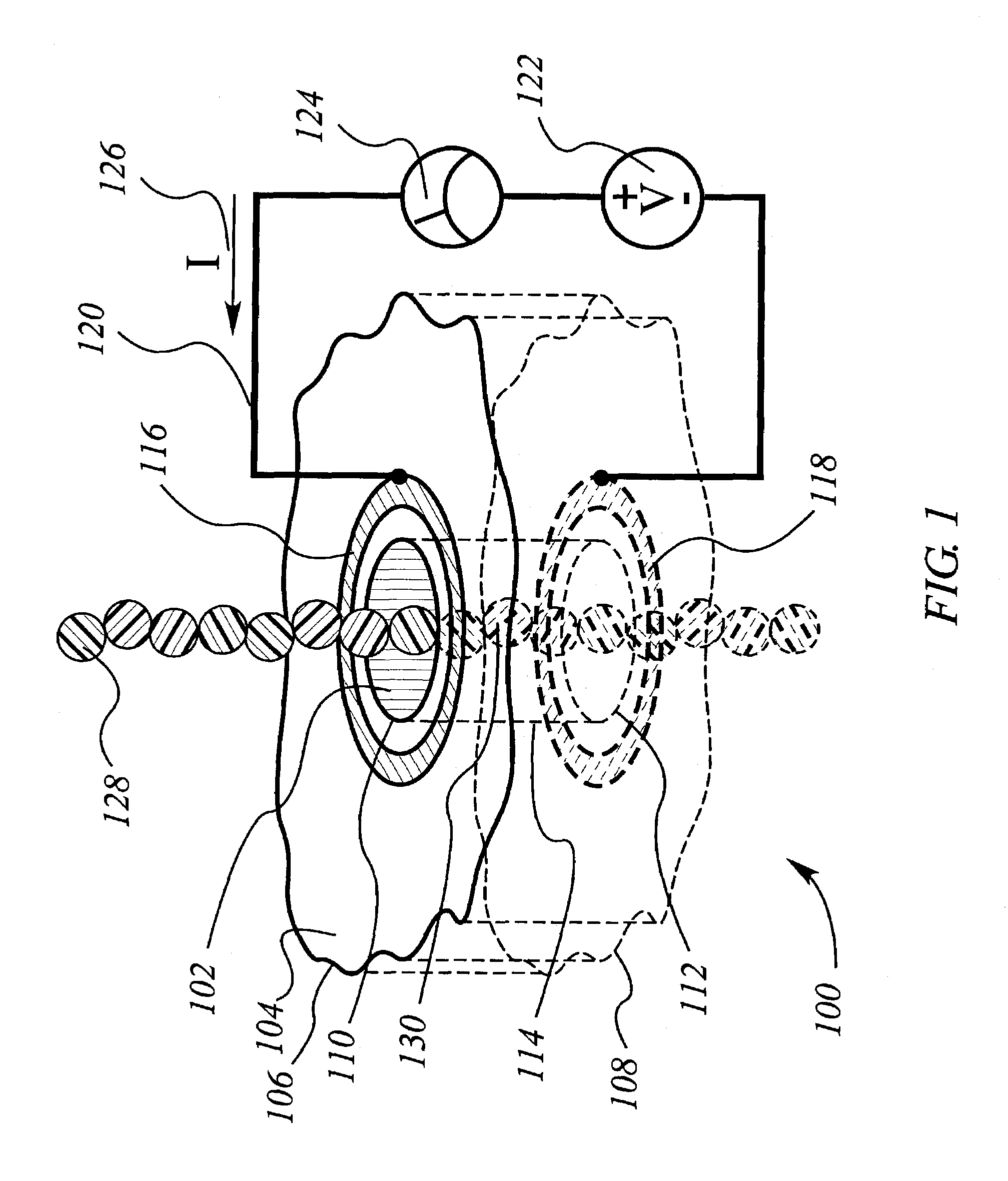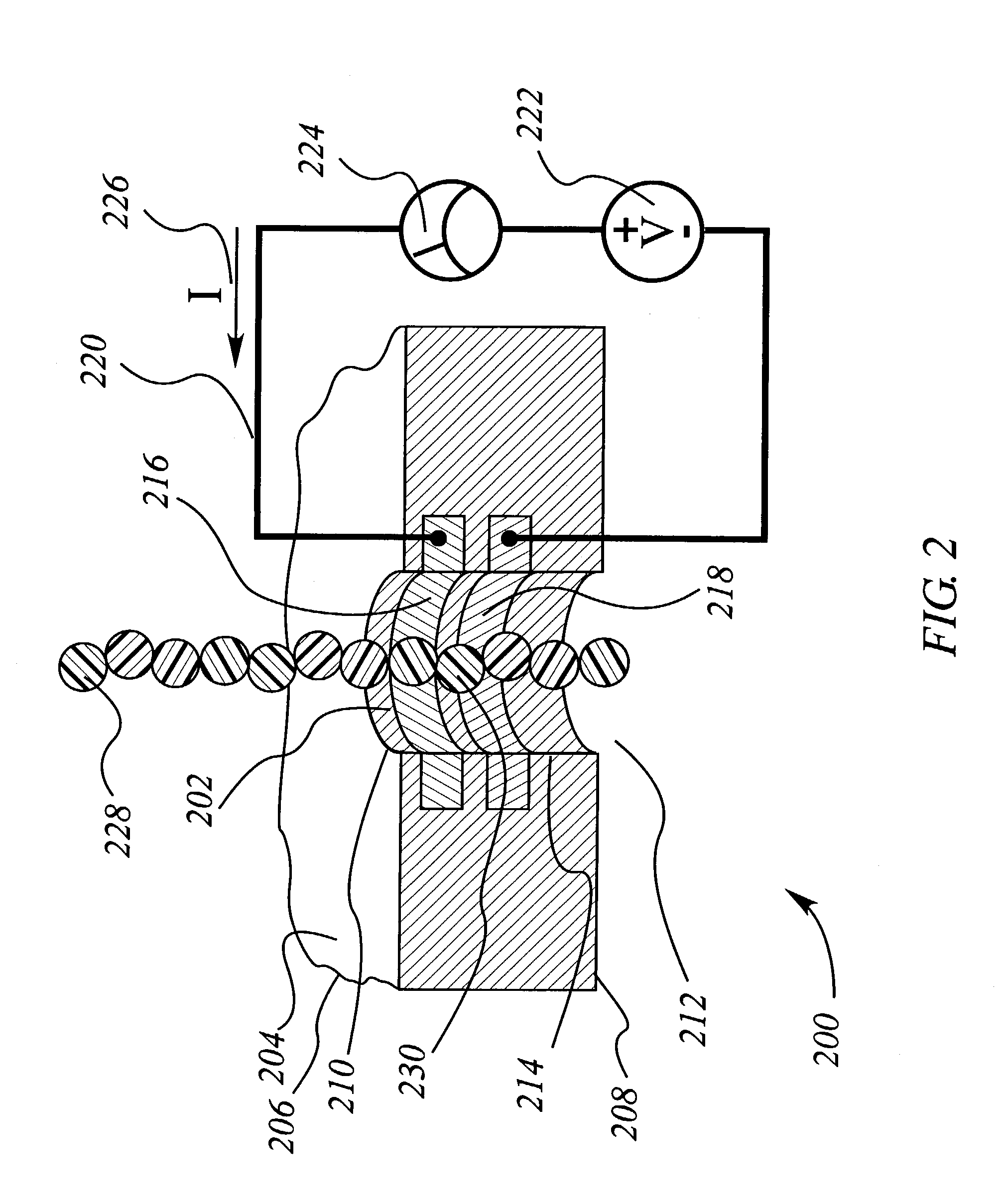Nanopore with resonant tunneling electrodes
a tunneling electrode and nanopore technology, applied in the field of biopolymers, can solve the problems of difficult or impossible to obtain information on the individual monomers in the biopolymer, difficult or impossible to expect this simple tunneling configuration to provide the specificity required for biopolymer sequencing, and may not be realized. , to achieve the effect of improving the detection and characterization of the nanoscale moiety
- Summary
- Abstract
- Description
- Claims
- Application Information
AI Technical Summary
Problems solved by technology
Method used
Image
Examples
embodiment 100
[0038]FIG. 1 illustrates a schematic embodiment 100 of the present invention. Nanopore 102 extends through a section of optional substrate 104. Substrate 104 has a first surface 106 and a second surface 108. First electrode edge 110 of nanopore 102 is coincident with first surface 106, and second electrode edge 112 is coincident with second surface 112. The interior wall 114 of nanopore 102 extends through the substrate 104.
[0039]First electrode 116 is adjacent nanopore 102, and second electrode 118 is adjacent nanopore 102. As illustrated, the interior diameters of first electrode 116 and second electrode 118 are greater than the interior diameter of wall 114 of nanopore 102, but this need not be the case, and the interior diameter of either electrode 116 or 118, or both, may be coincident with wall 114.
[0040]Electric circuit 120 makes contact to first electrode 116 and second electrode 118. Electric circuit 120 includes time-varying voltage source 122 and current sensing means 124...
embodiment 300
[0053]As seen in FIG. 3, embodiment 300 comprises a nanopore 308 that is wide near its second end and narrow near its first end. Substrate 306 comprises a region of a material such as silicon dioxide, and the second ring-shaped electrode 310 comprises a conductor such as platinum. Second electrode 310 is formed adjacent to the nanopore 308 in a manner that surrounds the perimeter of nanopore 308. On top of second electrode 310 a first insulator 312 is formed adjacent to the nanopore 308 in a manner that surrounds the perimeter of nanopore 308 and leaves exposed a perimeter portion 330 of second electrode 310. On top of first insulator 312, a first electrode 314 is formed adjacent to the nanopore 308 in a manner that surrounds the perimeter of nanopore 308. On top of first electrode 314 is optional insulator 316. Optional insulator 316 is formed adjacent to the nanopore 308 and is placed in a manner that surrounds the perimeter of nanopore 308 and leaves exposed a perimeter portion 3...
PUM
| Property | Measurement | Unit |
|---|---|---|
| angle | aaaaa | aaaaa |
| angle | aaaaa | aaaaa |
| diameter | aaaaa | aaaaa |
Abstract
Description
Claims
Application Information
 Login to View More
Login to View More - R&D
- Intellectual Property
- Life Sciences
- Materials
- Tech Scout
- Unparalleled Data Quality
- Higher Quality Content
- 60% Fewer Hallucinations
Browse by: Latest US Patents, China's latest patents, Technical Efficacy Thesaurus, Application Domain, Technology Topic, Popular Technical Reports.
© 2025 PatSnap. All rights reserved.Legal|Privacy policy|Modern Slavery Act Transparency Statement|Sitemap|About US| Contact US: help@patsnap.com



